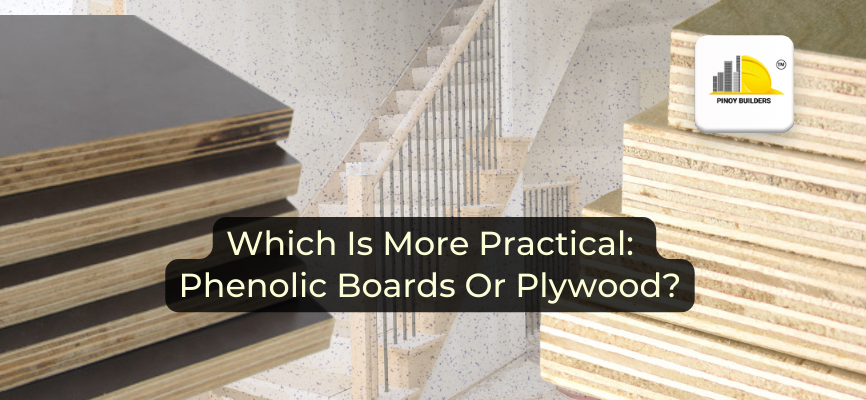The types of materials used in the construction industry are diverse, which is why the proper selection is a critical step before starting any construction project. Choosing the right material for a construction project is affected by several factors, such as the intended use, project budget, environmental considerations, and even availability.
Among the wide options for construction materials, phenolic boards and plywood emerge as two prominent contenders, each offering unique attributes and applications. In this article, we discuss and compare the practicality of both materials in their application, as well as their advantages and drawbacks across various contexts.
Which Is More Practical: Phenolic Boards Or Plywood?

Selecting construction materials carefully is important because they directly impact a building project’s quality, durability, safety, and sustainability. In other words, your choice of materials will affect the entire project, from its structural integrity to its energy efficiency and overall aesthetic. Selecting high-quality materials ensures longevity by reducing the need for frequent repairs or replacements. They can help in saving costs in the long run. Additionally, selecting eco-friendly and sustainable materials minimizes environmental impact and contributes to the development of a more responsible construction industry. Ultimately, thoughtful material selection is essential for creating a safe, durable, and aesthetically pleasing structure that meets both current and future needs.
The Search For What’s Practical
While many factors must be evaluated when choosing the right construction material, one remains one of the most important that many consider: practicality. When it comes to choosing between phenolic boards and plywood, it all boils down to the considerations unique to each project. Below are the practicality of the application, advantages, and drawbacks of phenolic boards and plywood to help you decide which is perfect for your needs.
Phenolic Boards

Phenolic boards consist of layers of phenolic resin and cellulose fibers, which makes them exceptionally durable and resistant to moisture and fire. Because of these attributes, phenolic boards are particularly suitable for demanding environments such as places with high moisture or heat.
Practicality in application
Phenolic boards are practical as construction and building materials. They are commonly used in construction as structural panels, partitions, wall claddings, and formwork due to their durability and resistance to moisture, chemicals, and fire. For furniture, phenolic boards are excellent materials that can be used for tabletops, cabinetry, and decorative panels due to their durability, moisture resistance, and ease of maintenance.
Advantages
Phenolic boards are highly durable and resistant to wear which makes them suitable for various applications in harsh environments. They also have a high strength-to-weight ratio and a high load-bearing capacity while being lightweight themselves. Phenolic boards exhibit excellent weather resistance and they can maintain their shape and dimensions even under changing environmental conditions. Lastly, phenolic boards are easy to clean and maintain so they have a long lifespan.
Drawbacks
Compared to other materials, phenolic boards are relatively expensive. They also have limited aesthetic options compared to more versatile materials like wood or plastic laminates. Lastly, phenolic resins can potentially affect indoor air quality.
Plywood

Plywood is a versatile material commonly used in construction, furniture making, interior design, and various other applications. It is composed of thin layers of wood veneer bonded together, and it is used in numerous applications in various industries. This material has multiple benefits, such as versatility and cost-effectiveness, although it also has its drawbacks.
Practicality in application
Plywood is widely used in construction for structural purposes like flooring, roofing, walls, and formwork. The material increases the strength, stability, and durability of any structure. For many, it is a practical choice of material due to its strength, ease of use, and affordability.
Advantages
Due to its cross-layered construction, plywood is less prone to warping, shrinking, or expanding compared to solid wood. It also comes in various grades, thicknesses, and sizes, making it suitable for a wide range of applications. In addition, plywood is stronger and more stable than solid wood, which is why many prefer it for structural applications.
Drawbacks
Plywood may be less desirable for certain high-end applications since it lacks the natural beauty and grain patterns found in solid wood. While some types of plywood are moisture-resistant, most plywood is susceptible to damage from prolonged exposure to moisture that can lead to delamination, swelling, and decay. Similar to phenolic boards, plywood also emits volatile organic compounds that can cause health risks in poorly ventilated environments.
Get On Board With The Right Material!

Both phenolic boards and plywood have various pros and cons that must be carefully considered when selecting materials for construction or furniture projects. Phenolic boards are perfect in demanding environments, making them ideal for applications such as bathrooms, kitchens, and other exterior uses. However, their higher initial cost and limited design options may be a drawback to some buyers. On the other hand, plywood’s versatility and cost-effectiveness make it a popular choice for a wide range of applications, especially where aesthetics is not a big concern. However, plywood’s lower durability compared to phenolic boards is significant.
Choosing between phenolic boards and plywood is based on specific project requirements, budget flexibility, and the desired balance between performance and aesthetics. By carefully weighing these factors, builders, designers, and DIYers can make informed decisions that best suit their construction and building needs.








